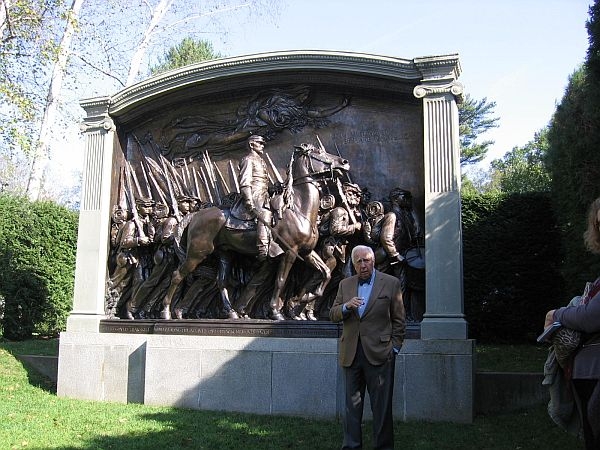
(Host) During the late summer and winter of two thousand ten and eleven writer and historian David McCullough made several trips to the Saint-Gaudens National Historic Site in Cornish, New Hampshire, to conduct extensive research for his latest book, "The Greater Journey: Americans in Paris." Last week, he returned. And VPR’s Betty Smith was there.
(Smith) Henry Duffy is curator at the Saint-Gaudens National Historic Site.
(Duffy) "It’s a book that talks about the variety of American artists, doctors, writers, other people who went to Paris as a kind of a magnet of culture and the arts, from the early part of the 19th century up into the turn of the 20th century. And of course, David is coming here today because of Augustus Saint-Gaudens, the great sculptor, who really epitomized not only the Civil War but American’s move into the Gilded Age as well."
(Smith) Saint-Gaudens was originally from New York City, but when he returned from Paris, he established a home and workshop in Cornish. The house, studio and extensive grounds are now part of the National Park Service. McCullough is enthusiastic about the resources he found in Cornish, including some of the original furniture from the Saint-Gaudens’ apartment in Paris.
(McCullough) "I knew what the furnishings were exactly because they’re here and it doesn’t get much better than that when you’re trying to recreate what kind of a life they were living."
(Smith) And of course, there is the art. Augustus Saint-Gaudens is best known for his heroic bronze figures from the American Civil War – works that include the Standing Lincoln monument in Chicago’s Lincoln Park, and the Shaw Memorial on Boston Common. His design for the 1907 Twenty Dollar Gold Piece is thought by many to be America’s most beautiful coin.
Saint-Gaudens was a perfectionist who often made minor changes to a project over multiple castings. As a result, original versions of much of his work can be seen here. McCullough has invited several members of the board of the National Park’s Conservation Association to join him on a walking tour of the house and grounds. Outside the gallery, the monument to Civil War Admiral David Farragut is surrounded by gravel paths.
(McCullough) "And after we leave here, we’re going to see his masterpiece, which is the Shaw Memorial, which is over this way. And I know it’s been said but I stress it again, this is the only place in America where you can see virtually all of Saint-Gaudens work in one spot, one day, one afternoon, or two weekends or whatever, but it’s a feast, a feast for the eye and the spirit."
(Smith) The Shaw Memorial commemorates Robert Gould Shaw and the African-American 54th Massachusetts Volunteer Infantry. McCullough says the important thing to remember is that historically, this is the first work of American art.
(McCullough) "… in which black Americans, African Americans, are portrayed as heroes. Always before they were portrayed as servants or in a servile role, or musicians or something like that. Here they’re heroes. Each is an individual. They are not the same faces. Every one, every face in there was done from numerous studies of different models, different men posing for it."
(Smith) The combined effect is a stunning representation of a watershed moment in American history.
(McCullough) "Until then they’d never been perceived as serving their country in a heroic role, but Saint-Gaudens has captured that and we feel it, we see it now, now more than a hundred years later because of his power as an artist. A great, great work."
(Smith) For VPR News, I’m Betty Smith in Cornish, New Hampshire.